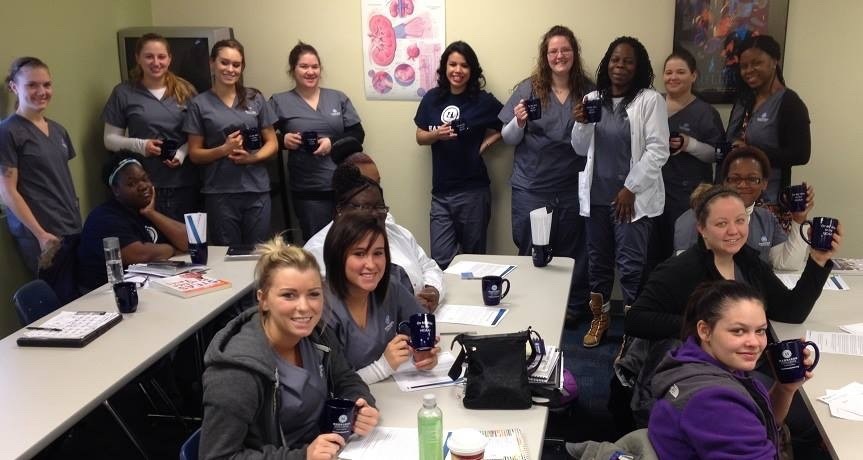Most people imagine clinical nursing when they think about nurses.
Think about what drew you to the nursing lifestyle.
Was it the pace, the IV’s, or the critical mind? Was it the empathy, the compassion, and nearness to other human life? Or perhaps it was the salary, schedule, and ability to work nights or PRN.
Whatever it was, you were right that the field of nursing truly does offer so many options for work/life balance, schedule, and passion.
However, have you ever considered that there are two sides to nursing life: clinical and non-clinical?
Both paths offer a great abundance of career opportunity, growth, and potential. In this article, you’ll learn more about them and see which path is right for you!
Table of Contents
Clinical vs Non-Clinical Nursing
Many of us picture nurses at the bedside, caring for patients, educating them, and sending them home.
But did you know that there are actually nurses all over the place? They work in:
- Management
- Leadership
- Education
- Quality
- Technology
Becoming a clinical registered nurse (RN) is a starting point (and often a happy ending point!) for many, but the paths after that are endless!
What Is Clinical Nursing Care?
Clinical nursing care involves acute patient care at the bedside.
This role is performed by a:
- Registered Nurse
- Nurse Practitioner (NP)
- Clinical Nurse Specialist (CNS)
- Certified Nurse Midwife (CNM)
- Certified Registered Nurse Anesthetists (CRNA)
What Is Non-Clinical Nursing Care?
Non-clinical nursing care may involve no patient care/bedside work.
The roles may include:
- Nursing Education
- Clinical management and leadership
- Informatics
- Forensic nursing
Clinical Nursing Paths
There is no shortage of clinical nursing paths you can take.
Here, we’ll discuss four of them.
Registered Nurse Path
A career as a RN requires a 2-year associate degree or a 4-year bachelor’s degree.
After program completion, RNs must sit for and pass the National Council Licensure Examination (N-CLEX). This is given by the National Council of State Boards of Nursing (NCSBN).
This is the starting place for nearly all of the following paths listed here.
According to the Bureau of Labor Statistics (BLS), median pay for a RN in the U.S. in 2019 was $73,300, with a strong job outlook.
Nurse Practitioner Path
A career as a NP requires a RN degree and additional schooling. These master’s level programs typically add about 2 extra years to your education.
NP’s can choose from a variety of specialties, including but not limited to:
- Pediatrics
- Women’s health
- Cardiac
- Oncology
Additional licensure is required after program completion.
The BLS reports an average annual salary of $115,800, with an incredible 45% expected growth over the next 10 years.
Certified Nurse Midwife Path
Another master’s level specialty requiring an additional 2 years of school, a CNM works in women’s health. They are most often involved in obstetric care and gynecology care.
Additional licensure is required after program completion.
The BLS reports the same average salary and expected job growth for CNMs as it does for NPs.
Certified Registered Nurse Anesthetist Path
This clinical nursing position also requires (at least) an extra 2 years of schooling.
Right now, master’s level education is appropriate for entry. However, by 2025, the goal is that all CRNAs are educated at the doctorate level.
After CRNA program completion, additional licensure is required.
The BLS reports the same average salary and expected job growth for CNMs as it does for NPs and CNMs.
Clinical Nursing Job Responsibilities and Expectations
Though each of these careers have different responsibilities and roles, they all involve a significant amount of patient interaction and care.
For the RN, this includes things like:
- Patient assessment
- Charting
- Daily cares
- Medication administration
- Team communication
NPs, CNMs, and CRNAs each (usually) work under a physician and with the RN.
NPs play more of an acute care leadership role. Their responsibilities can include:
- Diagnosing
- Assessing
- Prescribing
- Writing orders
CNMs are also involved in the management of:
- Pregnancy
- Labor
- Birth
- Postpartum
- Gynecology care
CRNAs often work in operating rooms and/or at the bedside administering spinals and epidurals.
Non-Clinical Nursing Paths
While most people imagine clinical nursing paths when they think about nurses, there are lots of great non-clinical nursing paths to choose from as well.
Here, we’ll discuss four for you to consider.
Nursing Education Path
Nurse educators may work inside or outside of a care facility. These facilities may include:
- Academic institutions
- Medical businesses
- Laboratories
The industry expectation is commonly that a nurse educator will have achieved a Master’s in Nurse Education. These programs are typically an additional 18-24 months, and there is no required additional licensure after program completion.
Nurse educators can expect to make an average of $83,000/year. However, this number can be significantly impacted by geography and which type of location or institution you work at.
Clinical Management and Leadership Path
Though this is a non-clinical job, it is highly likely that you would work in a clinical facility, such as a hospital or nursing home.
Clinical managers spend their time planning, directing, and coordinating the business plans of healthcare providers and facilities.
If you desire corporate-level work, you will likely need a master’s degree and/or an MBA. However, there are lower-level leadership positions that only require a bachelor’s degree.
Income here is extremely variable, but you can expect a baseline salary of around $100,000/year, and up to millions annually.
Nursing Informatics Path
If you’re interested in reading and analyzing data, the nursing informatics path may be right for you.
Educational requirements for a career in nursing informatics starts at the bachelor’s level.
These professionals may work in hospitals, health care facilities, and with corporations. The BLS reports an expected annual salary of $58,000.
Forensic Nursing Path
Forensic nurses are RNs trained to provide specialized care for patients with histories of victimization or violence.
They most commonly work in:
- Hospitals
- Community anti-violence programs
- Coroners’ and medical examiners’ offices
- Corrections institutions
- Psychiatric hospitals
Salary expectations are similar to those of a RN.
Non-Clinical Nursing Job Responsibilities and Expectations
As the non-clinical clarification indicates, these positions involve much more time away from patient care (if any).
These different professions are a significant part of the patient care team, but their work often occurs in the background, impacting:
- Financial decisions
- Budgeting choices
- Operations
- Technological considerations
However, the work done at these levels does trickle to the bedside. This affects:
- Patient/staff ratios
- Quality initiatives
- Supply changes
- Implementation of new technologies
Clinical vs Non-Clinical Nursing: Which Is Right For You?
Without question, the field of nursing offers so many opportunities.
While many men and women find a happy and fulfilling career at the bedside as a clinical RN, there are so many additional paths for those desiring a change or career growth.
With the right educational choices, the opportunities for a RN are nearly limitless.



